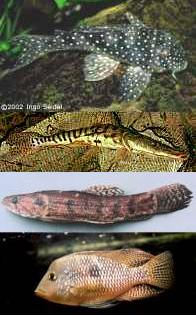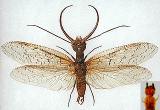Hunting and Feeding in the Neotropical Otter
Prey
 All authors agree that the main
prey of the Neotropical Otter is fish, followed by crustaceans. Pardini
(1998) gives fish in 93% of spraints, and crustaceans in 78%. In season,
the larvae of a megalopteran insect, flies of the genus Corydalus,
are taken in quantity. Favoured fish were catfish from the Loricariidae
and Callichthyidae families, Cichlidae, Pimelodidae, Auchenipteridae and
Erythrinidae (Kaspar et al,
2004), Hoplias malabaricus and Geophagus brasiliensis (Quadros
& Monteiro-Filho, 2001), and crustaceans include freshwater crabs
such as Trichodactylus fluviatilis and Aegli sp. The remains
of these in spraint is greater than the proportion in the environment,
indicating that the otters are preferentially choosing them, probably
because they are slow and easy to catch, conspicuous and palatable -
fast-swimming fish such as Piranha do not seem to be taken (Larivire,
1999). Soler (2002) notes
that in the waterways of the Lacandona Forest otters never overlook a fat
prawn!
All authors agree that the main
prey of the Neotropical Otter is fish, followed by crustaceans. Pardini
(1998) gives fish in 93% of spraints, and crustaceans in 78%. In season,
the larvae of a megalopteran insect, flies of the genus Corydalus,
are taken in quantity. Favoured fish were catfish from the Loricariidae
and Callichthyidae families, Cichlidae, Pimelodidae, Auchenipteridae and
Erythrinidae (Kaspar et al,
2004), Hoplias malabaricus and Geophagus brasiliensis (Quadros
& Monteiro-Filho, 2001), and crustaceans include freshwater crabs
such as Trichodactylus fluviatilis and Aegli sp. The remains
of these in spraint is greater than the proportion in the environment,
indicating that the otters are preferentially choosing them, probably
because they are slow and easy to catch, conspicuous and palatable -
fast-swimming fish such as Piranha do not seem to be taken (Larivire,
1999). Soler (2002) notes
that in the waterways of the Lacandona Forest otters never overlook a fat
prawn!
Neotropical Otters are opportunistic hunters, and will, in addition to
the main prey groups above, take anything they can get their paws on
easily - amphibians, repitles, mammals, birds and molluscs.
Fruit
 Quadros
& Monteiro-Filho (2000) investigated fruit seeds found in spraint
in the Atlantic Forest of Brazil, finding three kinds of locally abundant
fruit - Marlierea tomentosa (Guaparanga), Manilkara subsericea
(Sapoti or Sapotilla) and Pouteria lasiocarpa (a family of fruit
known variously as abiu, caimito, abieiro, abi, agulha, guta or abiurana).
All the spraint-found seed germinated, so given the likelihood of
deposition near a water supply with a ready-made packet of fertilizer, the
otter is a seed disperser for these plant species. Other otter species
anecdotally eat fruit, so it is likely that the Neotropical Otters find
these sweet, cherry-sized fruits palatable.
Quadros
& Monteiro-Filho (2000) investigated fruit seeds found in spraint
in the Atlantic Forest of Brazil, finding three kinds of locally abundant
fruit - Marlierea tomentosa (Guaparanga), Manilkara subsericea
(Sapoti or Sapotilla) and Pouteria lasiocarpa (a family of fruit
known variously as abiu, caimito, abieiro, abi, agulha, guta or abiurana).
All the spraint-found seed germinated, so given the likelihood of
deposition near a water supply with a ready-made packet of fertilizer, the
otter is a seed disperser for these plant species. Other otter species
anecdotally eat fruit, so it is likely that the Neotropical Otters find
these sweet, cherry-sized fruits palatable.
Hunting Schedule
In undisturbed areas, otters forage in middle and late afternoon. Where
there is
human disturbance, this changes to dawn and dusk, and in some areas,
otters become completely nocturnal Larivire
(1999).
Hunting Methods
Soler observed otters hunting on land, but most foraging is done in the water. Various tactics are used, but usually they pursue prey using their whiskers to detect water vibration, and catch it in their jaws. Smaller prey is consumed in the water, but larger items are taken to the shore to eat (Larivire, 1999).
| Neotropical River Otter |

